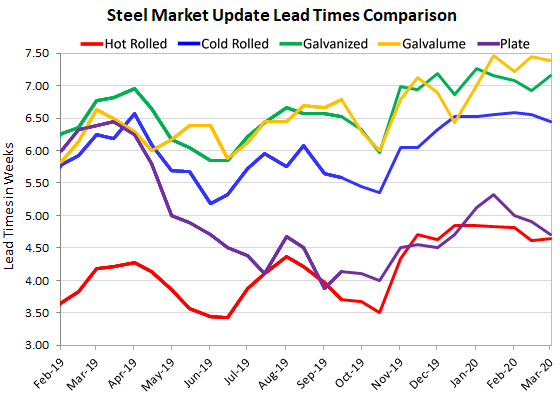SMU Data and Models

Steel Mill Lead Times: Not Much Change
Written by Tim Triplett
March 8, 2020
Average mill lead times for spot orders of flat rolled steel saw little change this past week. In fact, according to Steel Market Update’s surveys of the market, lead times have moved up or down by just a day or two, depending on the product, since the beginning of the year. Lead times for steel delivery are an indicator of demand at the mill level. The longer the lead time, the more busy the mill, and the less likely they are to negotiate on price. The current averages, which are higher than at this time last year, show the mills sustaining relatively healthy order levels.
Comparing the data, the average lead time for spot orders of hot rolled this week was 4.64 weeks, up slightly from 4.61 weeks in mid-February. Cold rolled was at 6.44 weeks, down slightly from 6.55 weeks two weeks prior. Galvanized was at 7.16 weeks, up slightly from 6.93, while Galvalume was at 7.38 weeks, down from 7.45. The average plate lead time this week was 4.71 weeks, slightly shorter than the 4.90 weeks in the prior survey.
SMU’s canvass of the market this week showed benchmark hot rolled steel prices moving up by $20 per ton following last week’s announcement of a $40 price increase by the mills. There has not yet been enough change in lead times to offer any guidance on whether the price increase is likely to stick.

Note: These lead times are based on the average from manufacturers and steel service centers who participated in this week’s SMU market trends analysis. Our lead times do not predict what any individual may get from any specific mill supplier. Look to your mill rep for actual lead times. Our lead times are meant only to identify trends and changes in the marketplace. To see an interactive history of our Steel Mill Lead Times data, visit our website here.

Tim Triplett
Read more from Tim TriplettLatest in SMU Data and Models

SMU’s June at a glance
A look at SMU data for the month of June.

SMU Survey: Buyers’ Sentiment rebounds from multi-year low
Both of SMU’s Steel Buyers’ Sentiment Indices edged higher this week. Current Sentiment rebounded from a near five-year low, while Future Sentiment rose to a two-month high

SMU flat-rolled market survey results now available
SMU’s latest steel buyers market survey results are now available on our website to all premium members.

SMU Survey: Sheet lead times pull back after early-June blip, plate holds
Following the uptick seen two weeks ago, lead times eased this week for all four sheet products tracked by SMU, while plate lead times held steady, according to this week’s market survey.

SMU Survey: Pricing power abruptly shifts to steel buyers
The majority of steel buyers responding to our latest market survey say domestic mills are more willing to talk price on sheet and plate products than they were earlier this month. Sheet negotiation rates rebounded across the board compared to early June, while our plate negotiation rate hit a full 100%.
